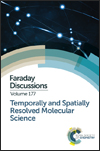Vibronic structure in the far-UV electronic circular dichroism spectra of proteins
Abstract
The Franck–Condon effect is considered and the vibrational structure of the πnbπ* transition of the peptide backbone is incorporated into matrix method calculations of the electronic circular dichroism (CD) spectra of proteins in the far-ultraviolet. We employ the state-averaged CASPT2 method to calculate the ground and πnbπ* excited state geometries and frequencies of N-methylacetamide (NMA), which represents the peptide chromophore. The results of these calculations are used to incorporate vibronic levels of the excited states into the matrix method calculation. The CD spectra of a set of 49 proteins, comprising a range of structural types, are calculated to assess the influence of the vibrational structure. The calculated spectra of α-helical proteins are better resolved using the vibronic parameters and correlation between the experimental and the calculated intensity of less regular β structure proteins improves over most wavelengths in the far-UV. No obvious improvement is observed in the calculated spectra of regular β-sheet proteins. Our high-level ab initio calculations of the vibronic structure of the πnbπ* transition in NMA have provided some further insight into the physical origins of the nature of protein CD spectra in the far-UV.
- This article is part of the themed collection: Temporally and Spatially Resolved Molecular Science

 Please wait while we load your content...
Please wait while we load your content...